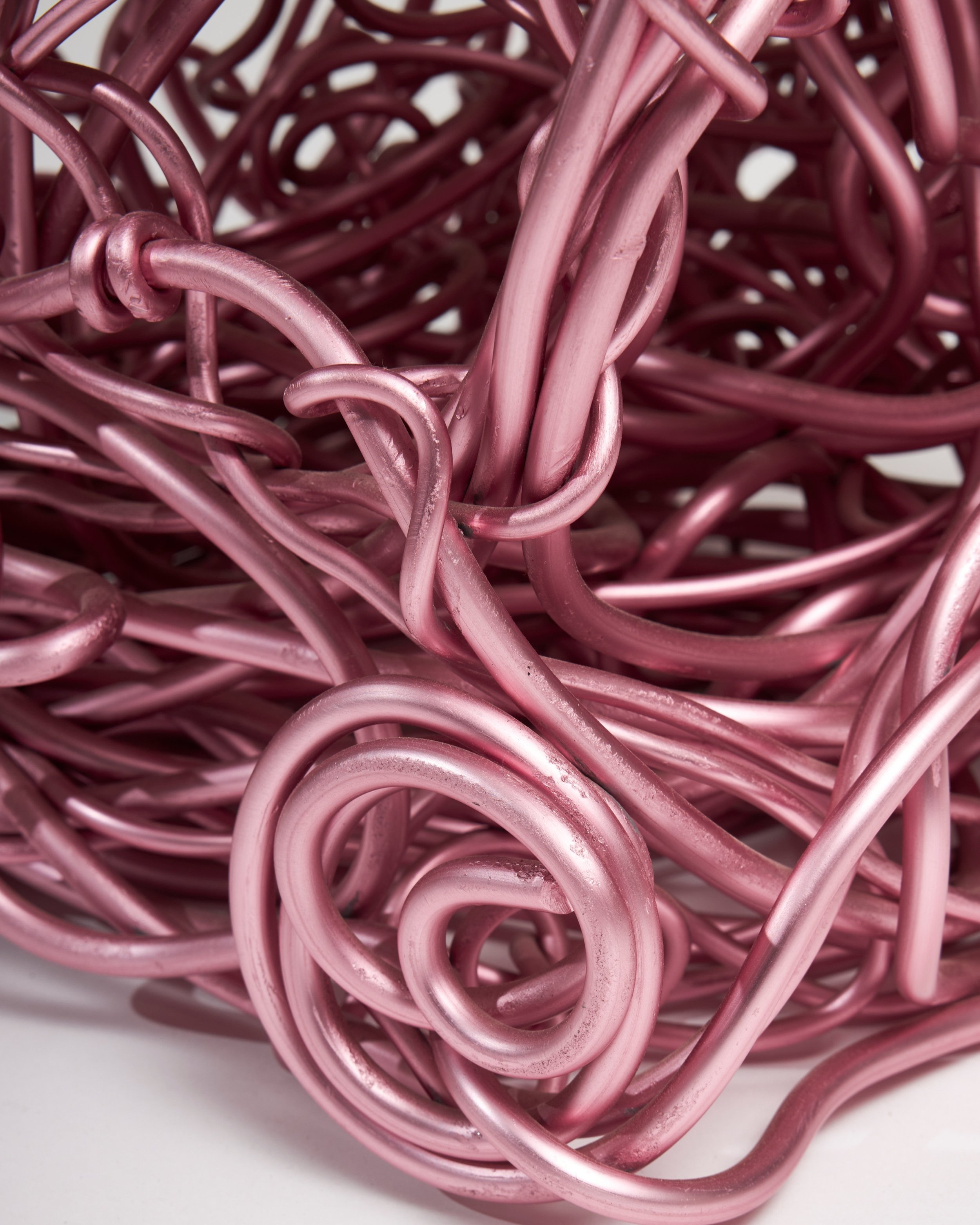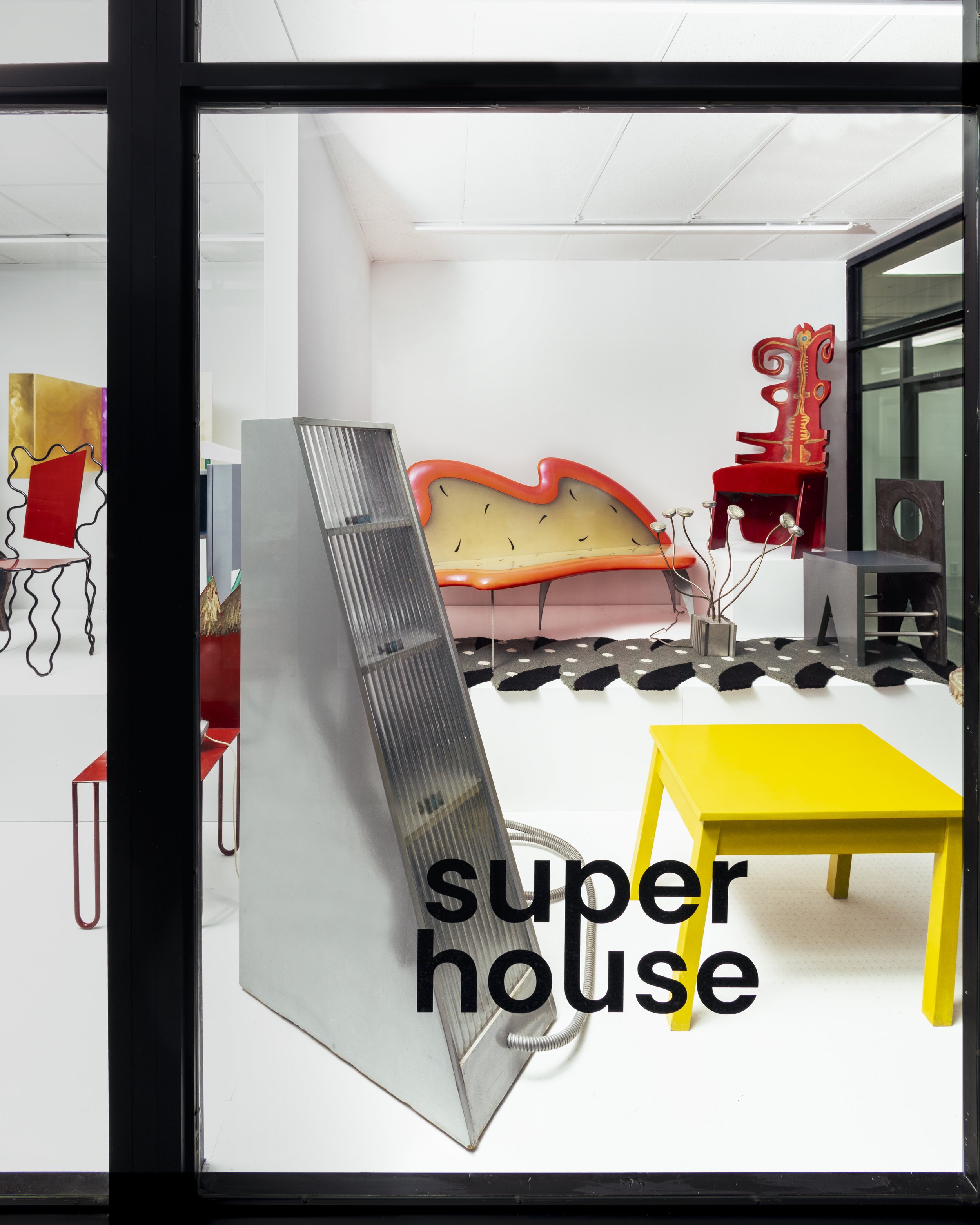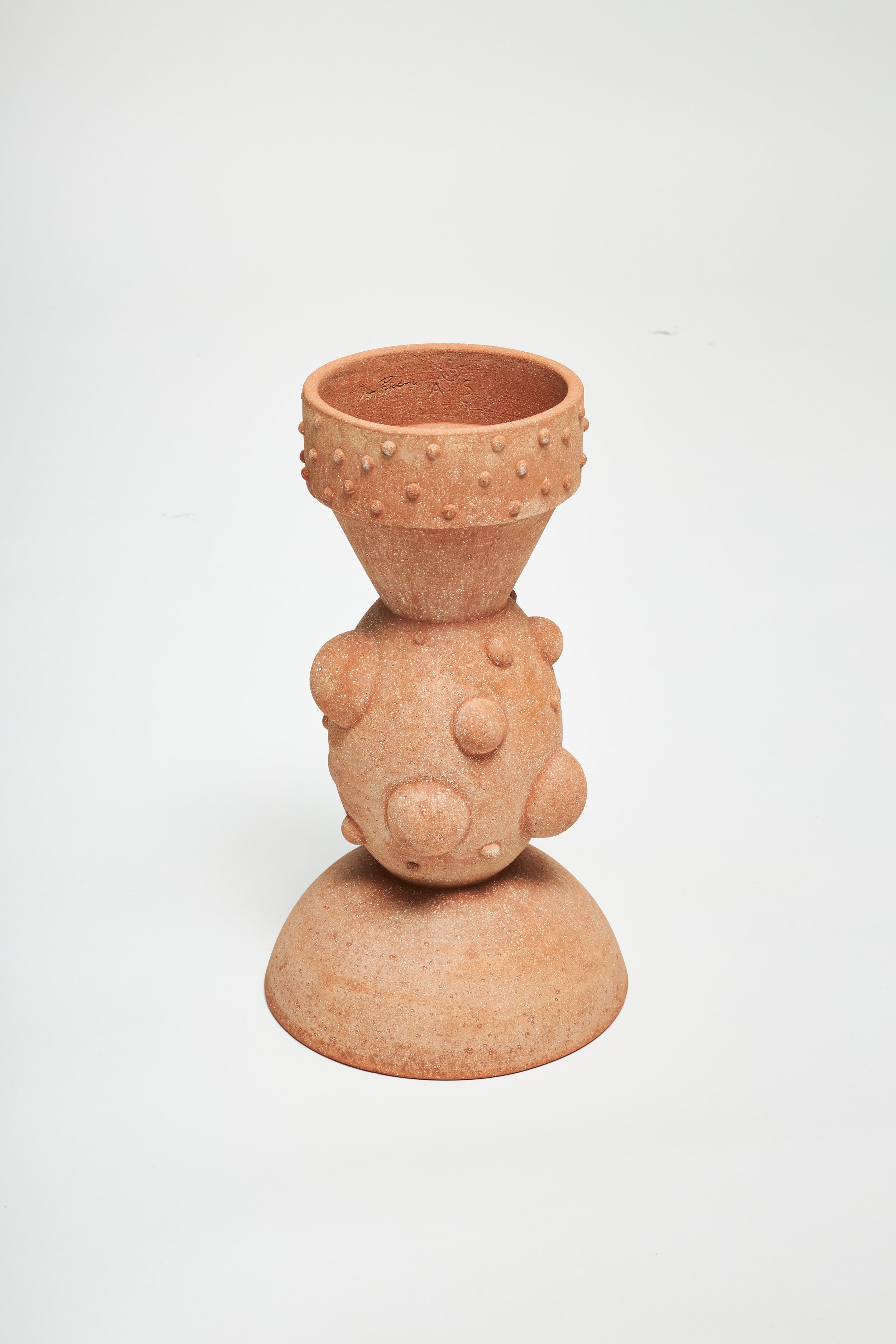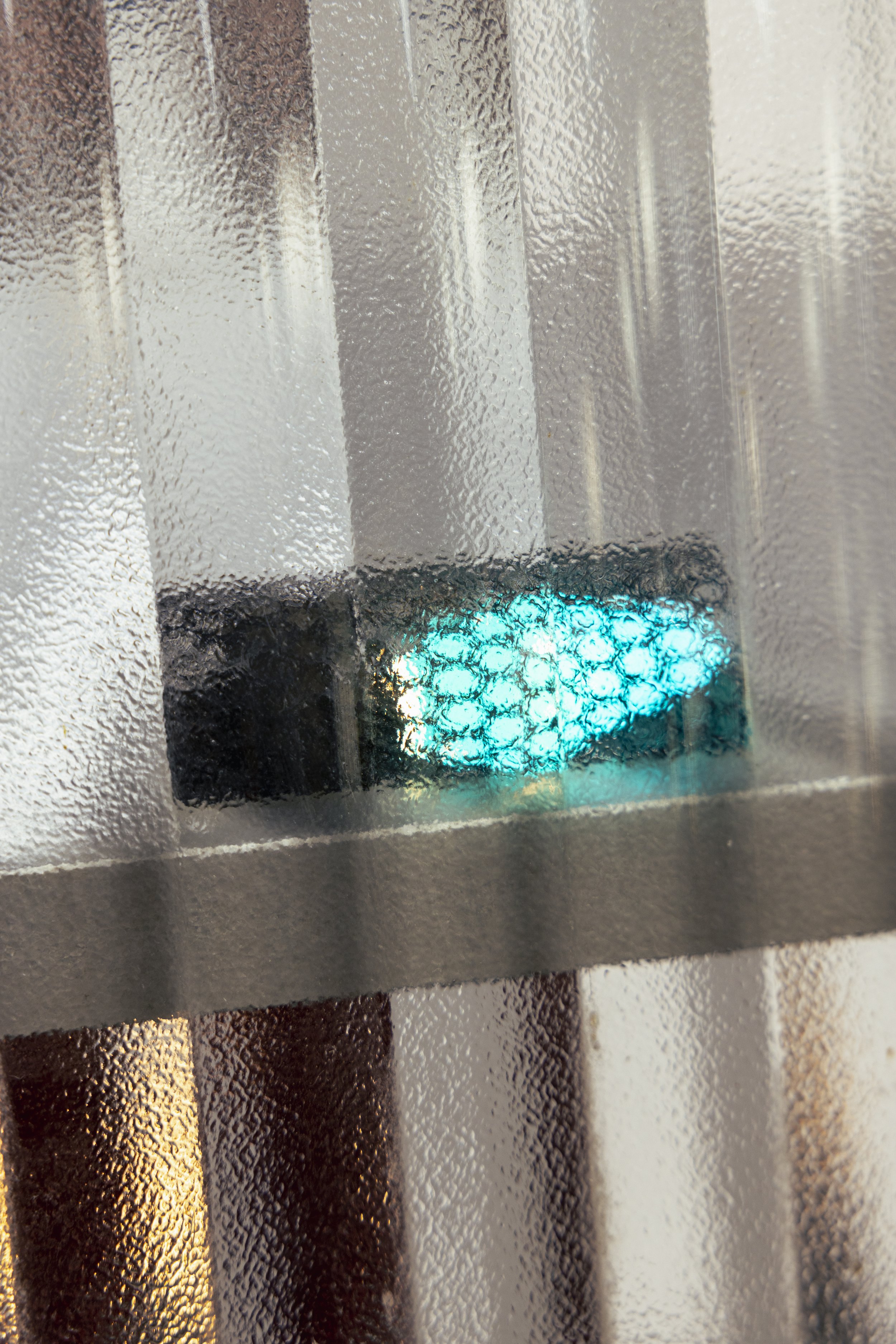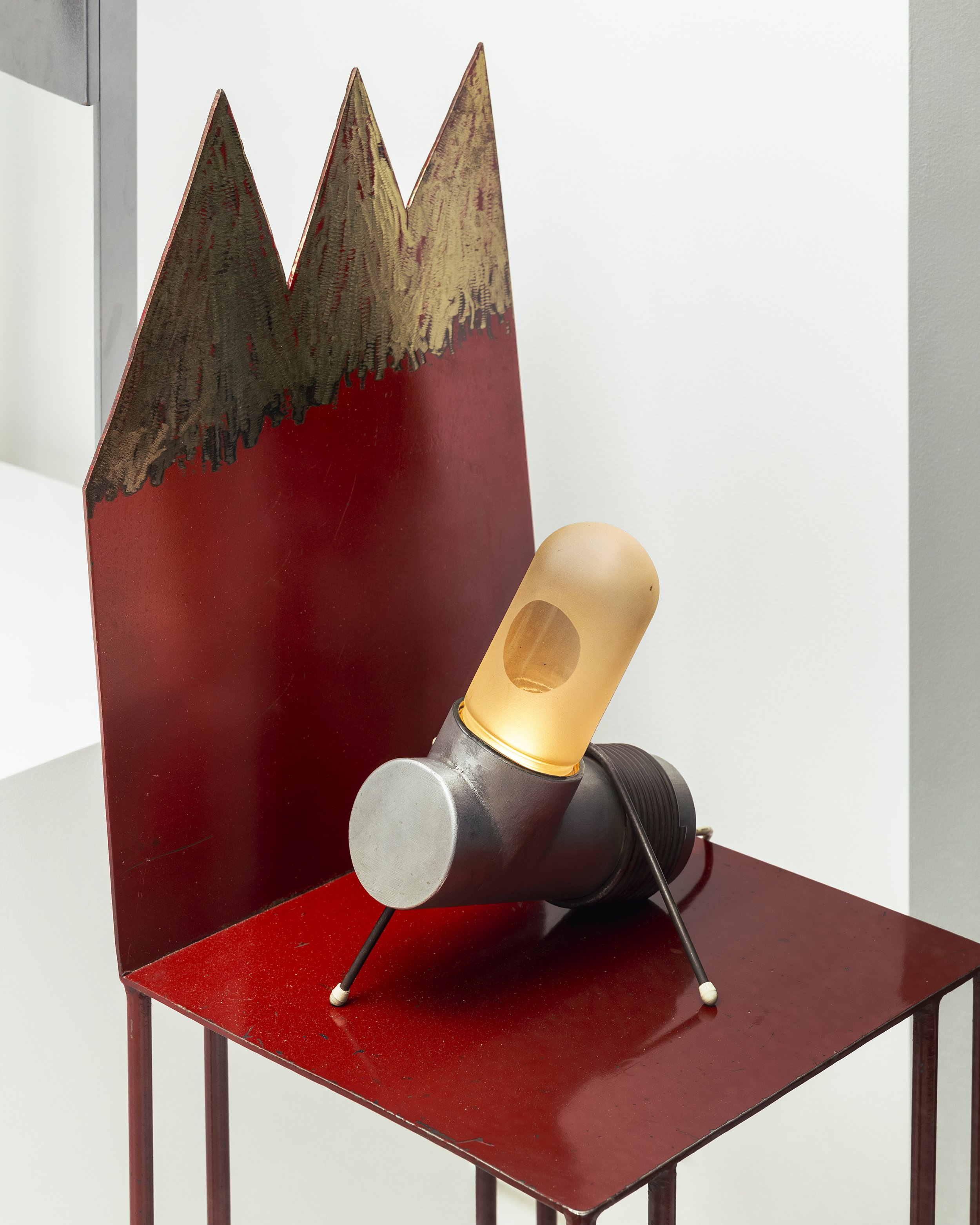Exhibitions
Return to Downtown
Various Artists
September 16 - October 30, 2022
Installation view (Photo: Luis Corzo)
Superhouse and Magen H Gallery are honored to present Return to Downtown, an exhibition of historical works from NYC’s Design Art movement of the 1980s and 1990s. The show takes place September 16 – October 30, 2022 at Superhouse Vitrine, 75 East Broadway, Second Floor, New York, NY.
Return to Downtown centers on 12 artists and designers at the forefront of the American Design Art movement, who worked in a broad range of styles, from Minimalism to Pop and from gestural to Industrial. Uniting the movement was the legendary gallery Art et Industrie, opened in 1977 by Rick Kaufman and Tracy Rust. The gallery inhabited various locations in Downtown Manhattan for 20 years and quickly became a locus of creative energy. Kaufman and Rust promoted the work of emerging (now historically significant) designers as well as established artists who were peers of Keith Haring, Robert Mapplethorpe, Talking Heads, Andy Warhol and others.
“Lower Manhattan in the ‘70s and ‘80s was a crucible of style, color and form, and of people and ideas: it was alive.” remarked Rick Kaufman.
For the exhibition, which covers both galleries of the newly expanded Superhouse Vitrine, Stephen Markos, founder and director of Superhouse, collaborated with Art et Industrie artists to curate works from their personal archives. For instance, Terence Main includes the iconic Queen Anne, Queen Anne chair and a table lamp from his first exhibition at Art et Industrie, both originally produced with his former partner in work and life, Laura Johnson Drake, under the moniker Main & Main. Elizabeth Browning Jackson, one of only a small handful of women to exhibit at Kaufman and Rust’s gallery offers work not seen in person in decades and of which there is little documentation, representing an incredible opportunity to discover the artist’s work. James Hong shows a rare pivoting cabinet as well as his multi-purpose bookshelf, inspired by the ruins of Ancient Egypt. And Howard Meister, known for his studied riffs on the chair, offers two of his earliest.
Along with the works by individual artists organized by Superhouse, the show presents several works from Magen H Gallery’s collection of contemporaneous art furniture. Important examples of Dan Friedman’s mental furniture are on view. While the late artist’s molded plastic USA Tables are done in a patriotic color palette, Friedman’s message was to call out a country the artist saw as “problematic.” Taking a place of importance is an anodized aluminum altarpiece by Forrest Myers, creator of the Soho public art installation, The Wall. A perspective defying table by sculptor Rafael Barrios is included along with many other works of the period.
Markos felt this was a particularly significant time to bring back the work by these trailblazers to Downtown Manhattan. Much like Soho in the time of Art et Industrie, Chinatown in which Superhouse calls home is booming with galleries and artist studios. Nearby Dimes Square is a meeting spot for New York’s culturati. Return to Downtown draws parallels with the New York of today with New York 40 years ago through the lens of Art et Industrie and its exhibited artists. The show celebrates and pays homage to these inspirational figures who paved the way for so many artists, designers, curators, and dealers today.
“I see Superhouse’s programming largely as a continuation of Rick and Tracy’s efforts to popularize Design Art.” says Markos. “Both galleries represent their time’s bleeding edge of functional art. It is an honor to be working with Magen H Gallery and the artists who launched their careers with Art et Industrie to bring this important collection of historical art furniture to Superhouse’s audience.”
Installation view
Forrest Myers Pink Tuffitt, 2007 (detail)
Elizabeth Browning Jackson Gloria, 1985
Elizabeth Browning Jackson Gloria, 1985
Howard Meister P.Strut, 1982
Howard Meister Johnny’s Girl, 1981
James Hong Swing Bar, 1986
Installation view
Dan Friedman USA Tables, 1993
Installation view
Carmen Spera Cafe Rapido, 1985
Dan Friedman Flowerpot, 1994
Rafael Barrios Mesa, 1980
Installation view
James Hong Karnak, 1979 (detail)
James Hong Karnak, 1979
Installation view
Main & Main Queen Anne, Queen Anne, 1982 (detail)
Main & Main Queen Anne, Queen Anne, 1982
Return to Downtown is dedicated to James (Jim) Evanson, Lisa Evanson, and Laura Johnson Drake who all sadly passed away during the organization of this show. Jim and Lisa were instrumental in the early stages of the exhibition planning and Laura’s contributions to the Design Art movement are highlighted in the show through her work with Main & Main and as an individual artist.
Detail
Artists and designers on view:
Carmen Spera
Dan Friedman
Elizabeth Browning Jackson
Forrest Myers
Howard Meister
James Hong
Laura Johnson Drake
Main & Main
Rafael Barrios
Richard Snyder
Terence Main
Terry Fugate-Wilcox
Carmen Spera
A self-taught painter and sculptor, Spera started showing his work in SoHo in 1977 and went on to join Art et Industrie in 1980. A pioneer of the Art Furniture movement, he has since shown his work in galleries and museums in New York, Los Angeles, San Francisco, Miami, Beijing and throughout Europe. Early in his career, Spera designed the legendary Capri Lounge for Jann Wenner’s Rolling Stone magazine and created sets for the television show “Miami Vice.” In the mid-’80s, Spera’s Apache Coat Rack was manu - factured by D-Tec Industriedesign in Düssel - dorf, Germany, and sold throughout Europe. Spera’s work has been featured in The New York Times, The Wall Street Journal, Metropolitan Home, ID magazine, Architektur und Wohnen, as well as dozens of design magazines and books. His pieces are included in the permanent collec - tions of the Museum of Art and Design in New York and the Ningbo Museum of Art in Ningbo, China. His work has been shown at the Brooklyn Museum in New York; the Hudson River Mu - seum in Yonkers, New York; and the Masur Mu - seum of Art in Monroe, Louisiana. Spera is re - presented by the Heller Gallery in New York; the Lois Lambert Gallery in Santa Monica, Califor - nia; and the c-NA Gallery in Beijing, China. While interested in experimenting with various mediums—painting, casting metal, carving wood—Spera has been particularly drawn to working unconventionally with glass. His work was recently featured in a glass exhibition at the New Britain Museum of American Art in New Britain, Connecticut.
Dan Friedman
Friedman was an internationally known artist, teacher, graphic designer, furniture and fantasy object designer. During the 1970s and ’80s, his innovative work was exhibited at several New York galleries, notably Fun Gallery, Art et Industrie and Red Studio. Later on, Friedman continued producing what he called “modern living” installations and “mental furniture” for other U.S. galleries, as well as for Galerie Neotu in Paris and Arredaesse, Driade, Studio Alchimia and Alessi in Milan. Much of this work, along with his graphic design, is in public collections, including the Museum of Modern Art and the Cooper-Hewitt, Smithsonian Design Museum, both in New York; the San Francisco Museum of Modern Art; the Montreal Museum of Fine Arts in Canada; the Gewerbemuseum in Basel, Switzerland; and the Seibu Museum of Art in Tokyo. Friedman was also known as a 1970s pioneer of so-called New Wave graphic design and typography, and later for his book Radical Modernism (with Jeffrey Deitch, Steven Holt and Alessandro Mendini), published by Yale University Press in 1994. He also contributed work to such publications as Artificial Nature (with Jeffrey Deitch, 1990) and Post Human (with Jeffrey Deitch, 1992) — all insightful discussions on the confluence of art, design, technology and modern culture. After collaborating with artists, designers and writers and engaging in a lucrative corporate graphic design career, Friedman devoted himself to teaching at Yale University in New Haven, Connecticut, and at the Cooper Union School of Art in New York, producing his own art and bridging the gap between art and design.
Elizabeth Browning Jackson
Elizabeth Browning Jackson was born in Providence, Rhode Island. After studying at The Rhode Island School of Design, University of New Mexico, and Capella Garden, Sweden, she graduated from San Francisco Art Institute. Since her mother studied at the Bauhaus under László Moholy-Nagy and her father’s family was involved with textiles in New England, it was only natural for her to translate her sculpture into furniture and rugs. After being introduced to Rick Kaufman and Art et Industrie, she was offered a solo show in September 1982. Jackson’s early furniture and textile work utilized industrial materials – automotive paints and vinyl, accessories from Canal Street stores, fiberglass, and acrylic yarns. Later Jackson’s work evolved into minimalist bent steel and luxurious wool. She is credited with creating shaped rugs in the forms of graphic splashes, waves, and geometric forms. Without the aid of rendering software, Jackson’s analog design process created animated works that are all about movement. She has shown throughout the United States as well as internationally in Paris and Tokyo. Her works are held in private and museum collections and have been featured in numerous publications. Elizabeth Browning Jackson lives and works in Rhode Island.
Forrest Myers
Myers began his studies at the San Francisco Art Institute in 1958. Greatly influenced by the works of Alexander Calder and Jackson Pollock, Myers, who is a musician, also found inspiration in jazz, especially in the work of Ornette Col - man. The two were friends and collaborators: Colman scored one of Myers’s experimental films and played at the Park Place Gallery in New York, where Myers moved in 1961. The Park Place Gallery was a groundbreaking artist cooperative that sprung up at a time when new concepts in sculpture were rapidly out - growing the traditional gallery. It counted Robert Grosvenor, Mark di Suvero, Tamara Mel - cher, Ed Ruda, Leo Valledor, Tony Magar, David Novros, Peter Forakis and Myers as its core group of artists. After it closed, Myers showed at the newly formed Paula Cooper Gallery and became a member of E.A.T. (Experiments in Art and Technology). With three other E.A.T. ar - tists, Myers was commissioned to design the Pepsi-Cola Pavilion at Expo ’70, a world fair held in Osaka, Japan. In 1964, Myers created his first sculpture transgressing the boundary between aesthetics and utility—a simple stool named Tendu, reconstructed to lean elegantly to one side. He re - turned to furniture in 1980 with an aluminum armchair, Cut Out, and with the Fold Chairs, ori - ginally designed in 1971. These pieces led to his first solo show at the Art et Industrie gallery in 1981. His early influences—jazz and Calder’s wire sculptures — can be seen in later works made of densely woven anodized wire.
Howard Meister
A fourth-generation furniture maker, Meister joined Art et Industrie in 1980, remaining with the gallery until it closed in 1997. He was one of five core members who, during the 1980s and ’90s, reinvigorated the artist-designed furni - ture genre in the U.S. His furniture has been featured editorially in more than a hundred publications internationally and was selected for the redesign of the executive offices of Rolling Stone magazine in New York. The seminal 1987 film Wall Street, by Oliver Stone, also used his pieces as set decoration. In 1990, Meister was a recipient of Metropolitan Home magazine’s Design 100 Award. Meister’s work has been featured in solo and group exhibitions in New York, Chicago, Detroit, San Francisco, Northampton and Austin, as well as in Toronto, London, Paris, Tokyo and Osaka. His pieces are included in the perma - nent collections of the Metropolitan Museum of Art, the Museum of Art and Design, the Brooklyn Museum and the Queens Museum, all in New York; the Art Institute of Chicago; the Rhode Island School of Design Museum in Providence; the Hudson River Museum in Yonkers, New York; the Victoria and Albert Museum in London; the Montreal Museum of Fine Arts in Canada; as well as museums in North Carolina, Florida and Texas.
James Hong
Hong is a furniture designer and interior architect with a degree in architecture from the University of California at Berkeley. His formative years were spent in Milan, Italy, working in the studio of legendary designer Gae Aulenti, whose work included furniture and lighting design as well as architectural interiors. After his stint in Europe, Hong moved to New York in 1978 to participate in a vibrant art scene that combined various facets of culture — art, fashion, photography, and theater. This unique environment provided the impetus for much of Hong’s furniture pieces, which reflected the surrounding cultural mix and responded to the art and design developments he had experienced in Europe. Hong’s work has been featured in many publications, including Vogue and Metropolis, and exhibited in numerous galleries and museums, among them Art et Industrie and Gallery 91; the Cooper-Hewitt, Smithsonian Design Museum; and the Queens Museum; all in New York; as well as the Newport Harbor Art Museum, in Newport Harbor, California.
Laura Johnson Drake
Drake was a furniture artist whose works have most recently been exhibited at the outdoor furniture exhibition of the Furniture Society’s Annual Conference held at the Massachusetts Institute of Technology in Cambridge, Massachusetts; the 2010 Design Quest furniture competition in Grand Rapids, Michigan (where her Pierced Chair won first prize); the Yodex (Young Designers’ Exhibition) in Taipei, Taiwan; the International Contemporary Furniture Fair in New York; the Neocon World Trade Fair in Chicago; the BECA Gallery in New Orleans, Louisiana; the Fine Furnishings Show in Milwaukee, Wisconsin; and in exhibitions affiliated with the Chicago Furniture Designers Association throughout the Chicago area. Her work has also been shown at High Point Market in High Point, North Carolina; the Evansville Museum of Arts, History and Science in Evansville and the Indiana State Museum in Indianapolis, both in Indiana. Drake held a Master of Art in Industrial Design from Purdue University in West Lafayette, Indiana, and a Master of Fine Arts in Sculpture from Southern Illinois University at Carbondale. She was an Associate Professor of Industrial Design at Purdue. Prior to her professional endeavors, Drake was represented by Art et Industrie in New York, which showed her works extensively, both nationally and internationally, in the 1980s and ’90s.
Main & Main
Main & Main was a collaborative endeavor between former husband and wife Terence Main and Laura Johnson Drake (then Laura Main). Lasting between 1980 and 1983, the artist duo created iconic works of furniture art that looked toward the future. The pair’s intention was to break away from the International Style and to create curious works that elicited viewer’s emotion, or as they put it, make the viewer “wake up and feel.” Their pieces have been exhibited widely and are included in institutional collections such as The Metropolitan Museum of Art (New York, NY) and The Art Institute of Chicago (Chicago, IL).
Rafael Barrios
Of Venezuelan descent, Barrios took drawing and painting classes at the Museo de Bellas Artes in Caracas, Venezuela, achieving recognition by winning the country’s National Youth Painting award in 1963. After completing his basic studies in Venezuela and Canada, Barrios received a scholarship from marketing communication firm J. Walter Thompson to attend the Ontario College of Art in Toronto, Canada, from which he graduated with honors in Pure Art as well as Communication and Design. On a scholarship from New York University, Barrios attended its graduate program in Fine Arts and Monumental Sculpture Techniques. Shown in group and solo shows in the U.S., Europe, South America and the Middle East, Barrios’s sculptures can been seen in public spaces in Caracas, Venezuela—at the Fundación Polar, the Seguros Venezuela Building and the Banco Consolidado (now CorpBanca) and Procter & Gamble headquarters—as well as at the Coca-Cola international headquarters in New York. His works are part the permanent collections of the Art Gallery of Ontario and the Carmen Lammana Foundation, both in Toronto, Canada; the National Art Gallery and the Sofía Ímber Museum of Contemporary Art, both in Caracas, Venezuela; as well as in the private collections of HRH Juan Carlos de Borbón of Spain and HRH Princess Gloria of Thurn und Taxis of Germany. Barrios has also worked as an art director for UNESCO, a creative consultant for cinematographic creations requiring a “Latin touch” and a stage designer for the late Vogue and Esquire photographer Chris von Wangenheim; for Danza Hoy at Expo ’92, a universal exposition in Seville, Spain; and for the Hervé Leger runway show at the Carousel du Louvre in Paris in 1996. He has also been a professor of Three-Dimensional Art and Advertising at the Design Institute of the Neumann Foundation in Caracas.
Richard Snyder
After receiving a Bachelor of Fine Arts from the School of the Museum of Fine Arts in Boston, Snyder made his career in the fields of art and design, practicing sculpture, painting, furniture design and fabrication, interior design, cabinetmaking, construction and industrial design. Along with extensive experience in a wide variety of materials and processes, Snyder also possesses a wide range of visual and experiential vocabulary acquired in his many travels through the Americas, Africa, the Middle East and Central and Southeast Asia. Snyder considers his objects to be not just about form, function, color, material and process, but rather to be fantasies with spirit, magic and story. During his seventeen years with the Art and Industrie gallery, Snyder participated in five one-man shows and more than twenty group shows, which established him as a major player in the American Art Furniture movement. His pieces have appeared in numerous publications and media around the world; they are included in numerous private collections worldwide as well as in the permanent collection of The Art Institute of Chicago. Snyder guest-lectures at the Rhode Island School of Design in Providence, the New School in New York, and Purchase College, State University of New York.
Terence Main
Main grew up on rural farmlands and attended the Herron School of Art and Design in Indiana - polis, Indiana, where he received a Bachelor of Arts in Visual Communication. After graduating from the Cranbrook Academy of Art in Bloomfield Hills, Michigan, with a Master of Fine Arts in Design, Main moved to New York, where he worked in a design office, co-founded the short-lived magazine Fetish, and formed the design partnership Main & Main with Laura Johnson, his wife at the time. Looking outside the boundaries of Classicism, Main responds to the rich material of Primitive art with furniture that intimates the power of Animist beliefs throughout human culture. The biomorphic elements of his pieces recall the fossilized remains of ancient creatures and ve - getation. They often have the look and feel of natural phenomena rather than man-made ob - jects and seem to exist within the generative and destructive cycles of nature. Main’s pieces can be found in the permanent collections of the Metropolitan Museum of Art and the Brooklyn Museum, both in New York; the Indianapolis Museum of Art in Indiana; and the Cranbrook Art Museum, in Bloomfield Hills, Michigan, among others. They have been featured in numerous publications and exhibitions worldwide.
Terry Fugate-Wilcox
Terry Fugate-Wilcox was born in 1944 in Kalamazoo, Michigan. He moved to New York in late 1968 with his wife, Valerie Monroe Shakespeare, and lived in TriBeCa for five decades. He showed sculpture and painting at 112 Greene Street (1972) and was represented by James Yu Gallery (1972–74) and Louis K. Meisel Gallery (1974–82), both in SoHo. He completed several public art projects in New York, New Jersey, Pennsylvania, and Illinois in the 1980s and showed at Fulcrum Gallery and Shakespeare’s Fulcrum in Manhattan from 1993 to 2002. After residing in Connecticut for a few years, Fugate-Wilcox has lived in Hudson, New York, since 2013, where he actively participates in the burgeoning art scene. His sculpture can be found in public and private collections around the world.




